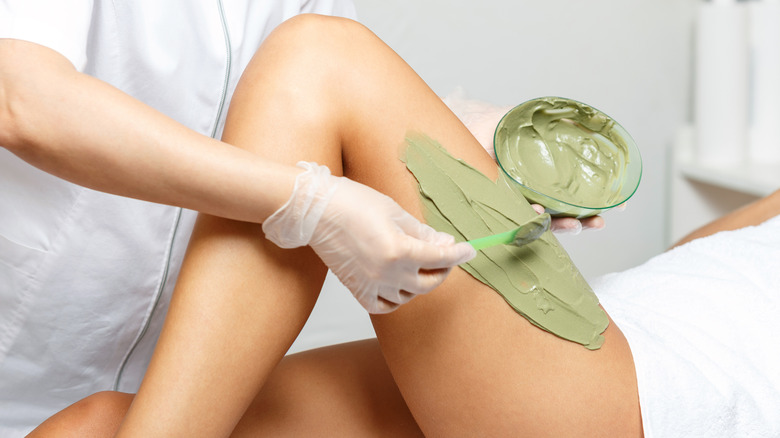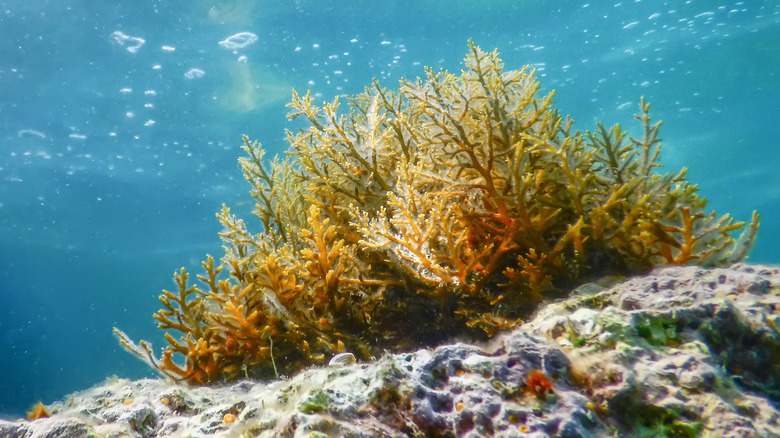Should You Be Using Seaweed On Your Skin?
We may receive a commission on purchases made from links.
You were standing right in front of it at the store, but that jar of seaweed gel seemed to float right by you. That was typical because the deluge of online ads for replenishing seaweed cream and nourishing seaweed toner can make your head swim. It may be time to face facts: The emergence of using a seaweed-based product for your skin just hasn't sunk in.
Given seaweed's history, this makes sense. On the one hand, people in the fourth century B.C. evidently put seaweed on their faces to relieve sunburns (via Oakmed Limited). But it took nearly two millenniums and plenty of patient, enterprising researchers to learn that seaweed's antioxidants and anti-inflammatory properties are a skincare treasure trove (via research published in Marine Drugs). In fact, Medical News Today says that seaweed "may have a moisturizing and protective effect on the skin, which may help to reduce acne, even out skin tone, and slow the signs of aging."
If your foot or toes have ever gotten entwined in seaweed, you can probably take a good guess as to why: its smooth, slippery, almost slimy qualities make it a natural conditioning agent. What's more, seaweed, which is a type of algae, is considered "dermatologically safe" (via Dalchem). The final decision is yours, of course, but it just might be time to take the plunge.
Learn about seaweed's purported benefits
Skin and beauty experts credit seaweed with helping the skin in two primary ways: improving common skin conditions as well as providing several "anti-aging" benefits. For example, Athré Med Spa says that products containing seaweed can be used to treat acne, discoloration, dry skin, hyperpigmentation, and rosacea. Seaweed's anti-aging properties can make it well-qualified to improve the appearance of fine lines and wrinkles. And this may be just for openers.
Seaweed may help hydrate, plump, detoxify, and rehydrate the skin. As you may have noticed, these results are predicted on a wide range of products that fall under the category of "anti-aging" — from face and eye creams to moisturizers and masks. While these products rely on a mix of ingredients, 100 Percent Pure theorizes that the ocean's "skin-loving vitamins and minerals" can deliver these results naturally.
If you've been in hot pursuit of these qualities but sometimes forget precisely why, hydrating is the best way to fend off lines and wrinkles. Plump skin also tends to feature fewer lines and wrinkles. Plump skin is usually smoother skin. It just looks healthy. Detoxifying the skin means removing dirt and other impurities so that skin remains bright and free of breakouts. And rehydrating becomes increasingly important as people get older. Even if you had oily skin in your youth up to your 40s, it's likely to get dry, at least in one region.
Take your pick of products
Assuming that seaweed has at least nicked your radar screen, you're correct to assume that you can purchase skin products made with seaweed at stores and online. You won't have to harvest it yourself, though reading about it just could inspire you to. At Seaflora, for example, the owners harvest seaweed by hand to ensure that it reproduces. Among other things, a whole seaweed plant is never uprooted.
Seaflora and companies like them make it possible to produce a full range of seaweed-infused products, including cleansers, face and eye creams, moisturizers, serums, and toners. Like integrating any new product into a routine, it may be best to start with a seaweed product that you know you'll use, like a cleanser or moisturizer, HUM Nutrition recommends. Keep in mind, though, that you may not see the word "seaweed" on a product label. Instead, you may see "marine algae" or "sea algae," which mean the same thing.
Although you should always read labels for instructions and restrictions, products made with seaweed are generally well-suited for people with all skin types. If you have sensitive skin, or you'd just like reassurance, try the product on a small patch of skin first. In fact, this is good advice for using any new product. With any luck, your foray into using an ocean-based product will go more than swimmingly; it will make you feel as though the world is your oyster.


